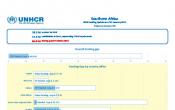Mozambique
Operation: Mozambique
Location
{"longitude":34,"latitude":-18,"zoom_level":5}
Latest update of camps and office locations 21 Nov 2016. By clicking on the icons on the map, additional information is displayed.
Key Figures
| 2016 end-year results | |
| 90% | of people of concern received valid identity documents |
| 2,700 | households received core relief items |
| 127 | latrines were constructed, bringing the latrine coverage at household level to 83.4% |
| 2017 planning figures | |
| 120 | A maximum duration of 120 days from the registration to first instance interview will be achieved |
| 100% | of refugee status determination procedures meet minimum procedural standards advocated by UNHCR |
| 100% | of people of concern will have access to primary health care |
| 100% | of refugees will be treated favourably in naturalization procedures |
Latest Updates
People of Concern
88%
Increase in
2016
2016
| 2016 | 38,534 |
| 2015 | 20,447 |
| 2014 | 17,861 |

[["Refugees",4671],["Asylum-seekers",12980],["IDPs",15128],["Returned refugees",5755]]
Loading ...
Mozambique
< Back
2016
{"categories":[2012,2013,2014,2015,2016,2017],"budget":[5.07071091,5.02878967,5.35033532,5.14927993,5.50288191,5.52294825],"expenditure":[4.03699283,3.49976519,3.11008688,2.89281237,2.77095579,null]}
{"categories":[2012,2013,2014,2015,2016,2017],"p1":[4.76192665,4.58333246,4.98677933,4.76918068,5.11505699,5.39732245],"p2":[0.30878426,0.44545721,0.36355599,0.38009925,0.38782492,0.1256258],"p3":[null,null,null,null,null,null],"p4":[null,null,null,null,null,null]}
{"categories":[2012,2013,2014,2015,2016,2017],"p1":[3.85013143,3.0543081,2.93373586,2.71037374,2.60526196,null],"p2":[0.1868614,0.44545709,0.17635102,0.18243863,0.16569383,null],"p3":[null,null,null,null,null,null],"p4":[null,null,null,null,null,null]}
Loading ...
CHOOSE A YEAR
- 2015
- 2016
- 2017
Working environment
Armed conflict in Tete, Sofala and Manica provinces in 2016 displaced thousands of Mozambicans to Malawi and Zimbabwe.The Government of Mozambique maintained its generous asylum policy and conducive environment for self-reliance and local integration of refugees.
Population trends
- Mozambique hosted more than 4,600 refugees and 12,980 asylum-seekers, nearly half of them in Maratane Camp.
- Close to 4,000 refugees and asylum-seekers were de-activated on UNHCR’s registration database following a verification exercise.
- Burundi was the main country of origin for new arrivals.
- A total of 48 per cent of the refugees and asylum-seekers are camp-based.
Achievements and impact
- UNHCR, with FAO, WFP and UN-Habitat, implemented the “Livelihoods for durable solutions: enhancing self-reliance in a protracted refugee situation” project for refugees and host communities to become self-reliant and improve local integration prospects through the promotion of agricultural and non-agricultural livelihoods.
- People of concern received legal assistance, as well as support to enhance self-reliance and access livelihoods. UNHCR also improved WASH facilities and infrastructure in Maratane camp and surrounding areas.
- 2,527 refugees and local students were able to access primary education. Secondary education (grades 8 and 9) was introduced in Maratane, with 244 students enrolled in 2016.
Unmet needs
- A protection and solutions strategy for urban refugees has not been drafted.
- UNHCR’s capacity to respond to the needs of IDPs and returnees is limited.
- Nutrition assistance to address anemia and a nutrition assessment are needed in Maratane Camp.
- Classrooms for secondary education could not be constructed, which further constrained the limited physical space available at the primary school.
Operational context and population trends
The situation in Mozambique has been marked by sustained economic growth (7.5 %). However concerns are growing about public debt levels and future economic prospects for investment, due to the decline of global commodity prices, including oil, gas and coal.- Heightened security issues continue to affect the country as a result of armed violence and increased political tensions between the Government and the opposition
- Mozambique is committed to strengthening local integration prospects for refugees; however mixed migration flows continue to present a challenge for Mozambique, which remains both a destination and a transit country for southward movements, in particular for Somalis and Ethiopians
- In the absence of alternative migration channels, the Government has continued to use the refugee camp to transfer intercepted Ethiopians transiting through Mozambique, which increases pressure on camp infrastructures and services.
Key priorities in 2016
UNHCR will continue to implement the strategy developed in 2014, working with the Government of Mozambique, donors, the UN country team, civil society organizations and beneficiaries to provide enhanced protection and assistance to people of concern. The following outputs are expected:- Strengthen existing and establish new strategic partnerships, particularly with the private sector, to create a more enabling and sustainable environment for local integration
- Support the Government on a phased five-year approach to progressively handing over camp services to the Government Move towards direct assistance in kind/cash or voucher, targeting only to the most vulnerable individuals through the existing social protection cash voucher programme
- Sustain Government support for protection documentation (e.g. asylum-seeker ID cards, biometrics, machine readable convention travel documents (MRCTDs), naturalization and diplomas)
- Encouraging development actors to include refugees in existing provincial/district programmes
- Support the Government with the implementation of the refugee status determination (RSD) backlog project, launched in 2014
- Provide eligible refugees with support to obtain alternative legal status or naturalization through the inter-ministry technical working group on local integration.



